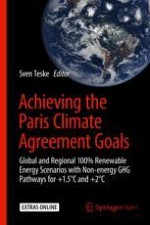9.1 Fossil Energy Resources—The Sky Is the Limit
Energy carrier | Reserves [EJ/year] | Resources [EJ/year] | Demand in 2015 [EJ/year] |
|---|---|---|---|
Conventional oil | 4900–7610 | 4170–6150 | 41.9 |
Unconventional oil | 3750–5600 | 11,280–14,800 | |
Conventional gas | 5000–7100 | 7200–8900 | 33.8 |
Unconventional gas | 20,100–67,100 | 40,200–121,900 | |
Coal | 17,300–21,000 | 291,000–435,000 | 16.5 |
9.2 Coal—Past Production and Future Trajectories Under Three Scenarios
9.3 Oil—Past Production and Future Trajectories Under the Three Scenarios
9.4 Gas—Past Production and Future Trajectories Under the Three Scenarios
9.5 Overview: Required Fossil Fuel Resources Under the 5.0 °C, 2.0 °C, and 1.5 °C Trajectories
2015 | 2020 | 2025 | 2030 | 2035 | 2040 | 2045 | 2050 | |
|---|---|---|---|---|---|---|---|---|
5.0 °C: Primary energy [PJ/a] | ||||||||
Coal | 140,895 | 147,324 | 153,529 | 167,795 | 179,666 | 191,078 | 196,692 | 200,680 |
Lignite | 19,835 | 18,836 | 18,550 | 18,573 | 18,597 | 19,028 | 19,546 | 19,562 |
Natural gas | 123,673 | 133,732 | 145,075 | 162,132 | 178,213 | 194,467 | 207,273 | 214,702 |
Crude oil | 166,465 | 173,082 | 181,520 | 190,294 | 197,300 | 204,563 | 208,561 | 210,970 |
5.0 °C production units | ||||||||
Coal [million tons per year] | 5871 | 6138 | 6397 | 6991 | 7486 | 7962 | 8196 | 8362 |
Lignite [million tons per year] | 2088 | 1983 | 1953 | 1955 | 1958 | 2003 | 2058 | 2059 |
Natural gas [billion cubic meters] | 3171 | 3429 | 3720 | 4157 | 4570 | 4986 | 5315 | 5505 |
Oil [thousand barrels per day] | 94,836 | 98,606 | 103,414 | 108,412 | 112,403 | 116,541 | 118,819 | 120,191 |
2.0 °C—primary energy [PJ/a] | ||||||||
Coal | 140,624 | 136,111 | 114,647 | 77,766 | 45,445 | 25,594 | 12,480 | 7568 |
Lignite | 19,835 | 16,779 | 8333 | 3203 | 1630 | 912 | 288 | 0 |
Natural gas | 123,770 | 132,209 | 130,797 | 126,054 | 105,321 | 78,390 | 42,535 | 9949 |
Crude oil | 166,472 | 164,438 | 141,523 | 109,213 | 71,812 | 45,013 | 26,649 | 15,461 |
2.0 °C—production units | ||||||||
Coal [million tons per year] | 5859 | 5671 | 4777 | 3240 | 1894 | 1066 | 520 | 315 |
Lignite [million tons per year] | 2088 | 1766 | 877 | 337 | 172 | 96 | 30 | 0 |
Natural gas [billion cubic meters] | 3174 | 3390 | 3354 | 3232 | 2701 | 2010 | 1091 | 255 |
Oil [thousand barrels per day] | 94,840 | 93,682 | 80,627 | 62,219 | 40,912 | 25,644 | 15,182 | 8808 |
1.5 °C— primary energy [PJ/a] | ||||||||
Coal | 141,275 | 125,431 | 84,267 | 41,360 | 14,243 | 9134 | 9363 | 9759 |
Lignite | 19,835 | 16,956 | 5006 | 2056 | 777 | 0 | 0 | 0 |
Natural gas | 123,426 | 132,241 | 125,494 | 104,349 | 80,940 | 50,883 | 23,202 | 7315 |
Crude oil | 166,472 | 163,957 | 114,986 | 68,449 | 36,541 | 22,923 | 16,772 | 14,794 |
1.5 °C production units | ||||||||
Coal [million tons per year] | 5886 | 5226 | 3511 | 1723 | 593 | 381 | 390 | 407 |
Lignite [million tons per year] | 2088 | 1785 | 527 | 216 | 82 | 0 | 0 | 0 |
Natural gas [billion cubic meters] | 3165 | 3391 | 3218 | 2676 | 2075 | 1305 | 595 | 188 |
Oil [thousand barrels per day] | 94,840 | 93,408 | 65,509 | 38,996 | 20,818 | 13,059 | 9555 | 8428 |
